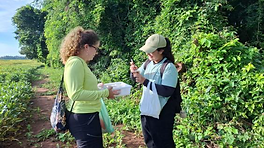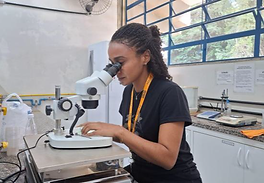Débora Cristina Rother
Tropical Plant Ecology



Nature-based solutions for the management of multifunctional landscapes
This project addresses urgent environmental management needs identified in the Municipal Conservation and Restoration Plans for the Atlantic Forest and Cerrado in seven municipalities of the Alto Paranapanema region (São Paulo, Brazil). One of the most critical issues is the loss of native vegetation, especially along waterways, where only about half of the required permanent protection areas remain.
Driven by agricultural expansion, this loss increases dependence on fertilizers, pesticides, and irrigation, with severe impacts on ecosystems, climate resilience, and human well-being.
We aim to co-create win–win restoration strategies that enhance ecosystem services (ES) essential for sustainable agroecosystems.
Our approach will:
-
Identify landscapes where restoration maximizes ES for agricultural pest control.
-
Develop functional plant species combinations to restore degraded areas while improving pest control and agroecosystem management.
-
Uncover governance, policy, and economic factors that shape land-use decisions and investment in restoration.
By working closely with local governments, NGOs, communities, and the private sector, our results will strengthen the management of multifunctional landscapes and support tropical forest restoration models that sustain both biodiversity and vital ecosystem services.
Finantial support: FAPESP - BIOTA Transformação (#2023-12033-2) - Auxílio à pesquisa 23/12033-2 - Controle biológico, Governança ambiental - BV FAPESP
LATEST PROJECTS
Floristic and functional plant diversity in human-modified landscapes




Species interactions, functional traits diversity and landscape structure are important attributes to the vegetation functionality. However, the degradation history of Atlantic forest has seriously threatened the biodiversity conservation and functionality of their ecosystems. To mitigate the negative impacts of environmental degradation, ecological restoration actions have been applied in the fragmented landscapes. Nevertheless, restoration actions are economically costly giving this practice the need of successful results. Despite its importance, there is limited information on the ecological restoration in the ecosystem scale. Additionally, there are no studies addressing the possibility of biological fluxes between natural and restored areas. The proposal of this project is to evaluate biological fluxes among restored areas and forest remnants; and the structure of the regional landscape with and without restored areas in the Atlantic Forest. For this study will be applied an approach that combines biological data with landscape metrics.
This study was supported by FAPESP (12/24118-8). Supervisor: Dr. Ricardo Rodrigues (ESALQ, USP). Collaborators: Dr. Robin Chazdon (Connecticut University), Dr. Milton Cesar Ribeiro (UNESP, Rio Claro), Msc. Ana Paula Liboni, and Isabella Fagundes (UNICAMP, Campinas).
Seed dispersal and demographic bottlenecks in the regeneration cycle








This work aimed at assessing the plant life cycles in bamboo and non bamboo stands in an Atlantic forest area where the native bamboo Guadua tagoara occurs at high densities. The specific goals of this study were: 1) knowing bird species associated with bamboo and non bamboo stands, identify the birds which belong to seed dispersers guild of Euterpe edulis, Sloanea guianensis and Virola bicuhyba and evaluate dispersal effectiveness and potential contribution to seed dispersal for the three plant species; 2) assessing the spatial pattern of early regeneration stages of plant communities in both stands, and 3) quantifying propagule losses as well as the probabilities of transition between each stage for all three plant species, and identify the demographic bottlenecks in recruitment that could collapse natural regeneration.
This study was supported by CNPq, and was framed within the Biota project also supported by FAPESP (99/09635-0). Collaborators: Dr. Marco Aurélio Pizo (UNESP, Rio Claro), Dr. Pedro Jordano (Estación Biológica de Doñana, CSIC), Msc. Ana Elena Muler, and Dr. Ricardo Rodrigues (ESALQ, USP).
Seed rain and seedling establishment at different microhabitats in the Atlantic forest


Bamboos often negatively affect tree recruitment, survival, and growth, leading to arrested tree regeneration in forested habitats. Studies so far have focused on the effects of bamboos on the performance of seedlings and saplings, but the influence of bamboos on forest dynamics may start very early in the forest regeneration process by altering seed rain patterns. In this project we tested the prediction that the density and composition of the seed rain and seedlings are altered in stands of Guadua tagoara, a large-sized woody bamboo native from the Brazilian Atlantic Forest, compared to forest patches without bamboos.
This study was supported by FAPESP (03/11073-7), and was framed within the Biota project also supported by FAPESP (99/09635-0). Collaborators: Dr. Marco Aurélio Pizo (UNESP, Rio Claro), Dr. Ricardo Rodrigues (ESALQ, USP), and Dr. Pedro Jordano (Estación Biológica de Doñana, CSIC).